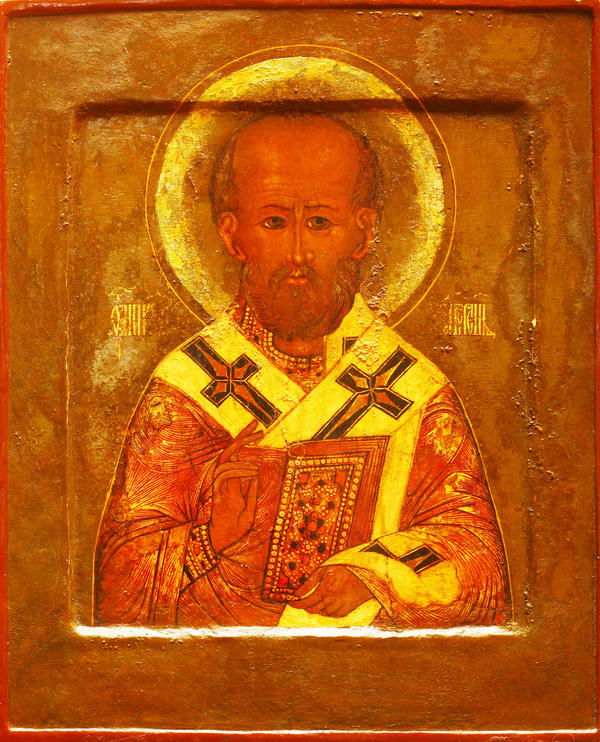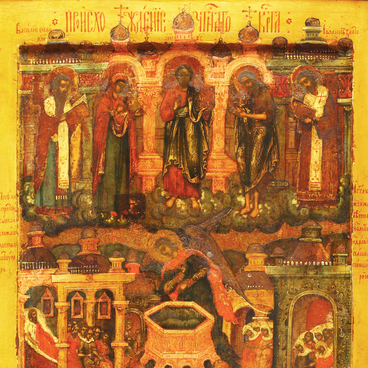Saint Nicholas of Myra is one of the most revered Christian saints. Orthodox Christians often call him the Wonderworker or the Pleaser. He was a real person and lived in the city of Myra in the province of Lycia, now called Antalya. He was a bishop and headed a local Christian community. According to legends, on the Christmas Eve he presented a rich dowry to three daughters of the poorest man in the city and his gift gave rise to a tradition of Christmas gift giving to children.
During early Christianity parishioners had right to choose a bishop. Priest Nicholas was young but already known for his wisdom, kindness and saintly life. He distributed the wealth inherited from his parents to the poor. His service started under the rule of the emperor Diocletian known for his persecution of Christians. New rulers of the Byzantine Empire were much more tolerant. According to his Life, a divine sign marked the election of Nicholas the head of the diocese.
Miraculous healings started in the church in which the bishop had served and was buried near the altar. In the 11th century the relics of Saint Nicholas was transferred from Myra already controlled by the Turks to the Italian town of Bari. In order to commemorate this translation, the Orthodox Church had a special feast day called Nikola Veshny (Saint Nicholas of Summer). It was a day of the year to start agricultural works in fields and pasture horses at night.
In Russia Saint Nicholas was called the Pleaser and considered the patron of travelers, mariners, prisoners, sick persons, and domestic animals. A church or cathedral dedicated to Saint Nicholas the Wonderworker was erected in every town and every house had a sanctuary lamp lighted before the icon of this kind saint. It is believed that his intercession can make satisfaction for the greatest sins and save from the torments of the damned. There are many canonical variants of icons of Saint Nicholas. His bust-length image with the Gospel Book in his hands is the most commonly used one.
The icon of Saint Nicholas the Wonderworker was bought from a citizen of the town of Ruzaevka in 1987. This is a bust picture of the saint who is holding a closed Gospel Book in his left hand while making a blessing sing with two fingers of his right hand. He is looking at a prayer with his big, kind and all understanding eyes and his glance seems to penetrate into the prayer’s very soul.
A linen canvas was glued to a lime-tree panel and then covered with levkas, a special ground of powered chalk mixed with fish glue and linseed oil. The icon was painted with tempera, a paint made from mineral pigments mixed with egg yolk. The brass riza was silvered.
Very modest means were enough to an unknown but obviously very talented painter of this icon to convey sympathy and compassion in the saint’s eyes. The small size is typical of home icons. Undoubtedly, many generations of this family confided their sorrows to the saint and hoped for his help and consolation, which they often received.
During early Christianity parishioners had right to choose a bishop. Priest Nicholas was young but already known for his wisdom, kindness and saintly life. He distributed the wealth inherited from his parents to the poor. His service started under the rule of the emperor Diocletian known for his persecution of Christians. New rulers of the Byzantine Empire were much more tolerant. According to his Life, a divine sign marked the election of Nicholas the head of the diocese.
Miraculous healings started in the church in which the bishop had served and was buried near the altar. In the 11th century the relics of Saint Nicholas was transferred from Myra already controlled by the Turks to the Italian town of Bari. In order to commemorate this translation, the Orthodox Church had a special feast day called Nikola Veshny (Saint Nicholas of Summer). It was a day of the year to start agricultural works in fields and pasture horses at night.
In Russia Saint Nicholas was called the Pleaser and considered the patron of travelers, mariners, prisoners, sick persons, and domestic animals. A church or cathedral dedicated to Saint Nicholas the Wonderworker was erected in every town and every house had a sanctuary lamp lighted before the icon of this kind saint. It is believed that his intercession can make satisfaction for the greatest sins and save from the torments of the damned. There are many canonical variants of icons of Saint Nicholas. His bust-length image with the Gospel Book in his hands is the most commonly used one.
The icon of Saint Nicholas the Wonderworker was bought from a citizen of the town of Ruzaevka in 1987. This is a bust picture of the saint who is holding a closed Gospel Book in his left hand while making a blessing sing with two fingers of his right hand. He is looking at a prayer with his big, kind and all understanding eyes and his glance seems to penetrate into the prayer’s very soul.
A linen canvas was glued to a lime-tree panel and then covered with levkas, a special ground of powered chalk mixed with fish glue and linseed oil. The icon was painted with tempera, a paint made from mineral pigments mixed with egg yolk. The brass riza was silvered.
Very modest means were enough to an unknown but obviously very talented painter of this icon to convey sympathy and compassion in the saint’s eyes. The small size is typical of home icons. Undoubtedly, many generations of this family confided their sorrows to the saint and hoped for his help and consolation, which they often received.



